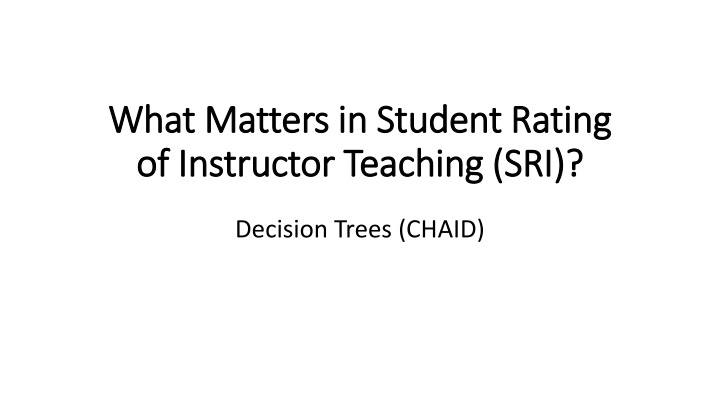
Student Ratings & Instructor Teaching Through Analytics
Explore the significance of student ratings in evaluating instructor teaching using Decision Trees and Anomaly Detection. Discover the variables used and application of analytics in institutional research, including student segmentation and course planning.
Download Presentation

Please find below an Image/Link to download the presentation.
The content on the website is provided AS IS for your information and personal use only. It may not be sold, licensed, or shared on other websites without obtaining consent from the author. If you encounter any issues during the download, it is possible that the publisher has removed the file from their server.
You are allowed to download the files provided on this website for personal or commercial use, subject to the condition that they are used lawfully. All files are the property of their respective owners.
The content on the website is provided AS IS for your information and personal use only. It may not be sold, licensed, or shared on other websites without obtaining consent from the author.
E N D
Presentation Transcript
What What Matters in Student Rating Matters in Student Rating of Instructor Teaching (SRI)? of Instructor Teaching (SRI)? Decision Trees (CHAID)
Competitive Competitive Positioning Cluster Analysis (K-Means) Positioning
Variables Used in the Analysis 1. Books per Faculty 2. Articles per Faculty 3. Citations per Faculty 4. Awards per Faculty 5. Grant Dollars per Faculty (federal) 6. Grants per Faculty 7. Conference Proceedings per Faculty
Anomaly Detection Anomaly detection models are used to identify outliers, or unusual cases, in the data. Unlike other modeling methods that store rules about unusual cases, anomaly detection models store information on what normal behavior looks like. Anomaly detection is an exploratory method designed for quick detection of unusual cases or records that should be candidates for further analysis. For example, the algorithm might lump records into three distinct clusters and flag those that fall far from the center of any one cluster. Source: SPSS, 2014
Application Application of Analytics in Institutional Research of Analytics in Institutional Research Categorize your students Classification/Segmentation Cafeteria meal planning Student housing planning Identify high risk students Estimate/predict alumni contributions Predict new student application rate Predict students retention/Alumni donations Neural Nets/Regression Course planning Academic scheduling Identify student preferences for clubs and social organizations Group similar students Clustering Identify courses that are taken together Association Faculty teaching load estimation Course planning Academic scheduling Predict alumni donations Predict potential demand for library resources Find patterns and trends over time Sequence Source: Thulasi Kumar, 2004






















